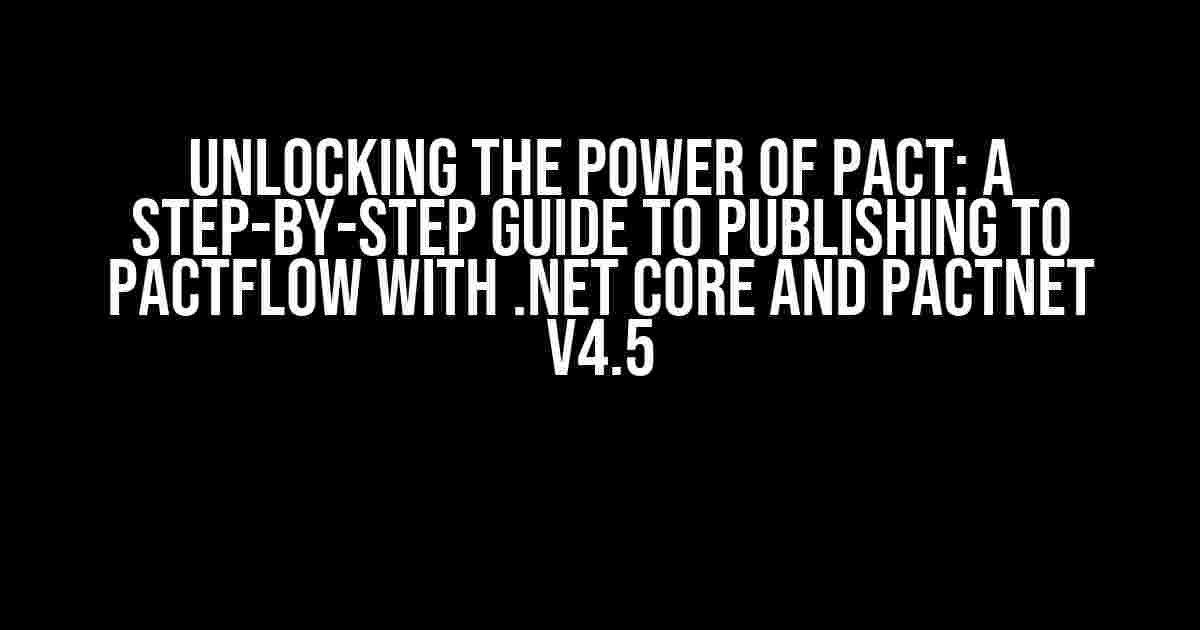Are you tired of struggling with contract testing in your .NET Core application? Do you want to ensure that your APIs are reliable and scalable? Look no further! In this comprehensive guide, we’ll show you how to publish pacts to Pactflow using .NET Core and PactNet v4.5. By the end of this article, you’ll be a Pactflow pro, and your contract testing woes will be a thing of the past!
- What is Pactflow?
- Prerequisites
- Step 1: Create a New .NET Core Project
- Step 2: Install PactNet v4.5
- Step 3: Create a Pact
- Step 4: Configure PactNet
- Step 5: Create a Pact Interaction
- Step 6: Write a Test for the Pact Interaction
- Step 7: Publish to Pactflow
- Step 8: Verify Your Pact on Pactflow
- Conclusion
- FAQs
What is Pactflow?
Pactflow is a contract testing platform that enables you to define, negotiate, and manage contracts between your APIs. It’s an essential tool for ensuring that your APIs work seamlessly together, even when changes are made. With Pactflow, you can automate contract testing, reduce errors, and increase confidence in your API integrations.
What is PactNet v4.5?
PactNet is a .NET implementation of the Pact testing framework. PactNet v4.5 is the latest version, which provides a more robust and efficient way of creating and testing pacts. With PactNet v4.5, you can easily integrate contract testing into your .NET Core application and publish pacts to Pactflow for centralized management and verification.
Prerequisites
Before we dive into the tutorial, make sure you have the following installed and configured:
- .NET Core 3.1 or higher
- PactNet v4.5 NuGet package
- PactFlow account and API key
- A basic understanding of .NET Core and contract testing
Step 1: Create a New .NET Core Project
Open Visual Studio and create a new .NET Core Web API project:
dotnet new webapi -n MyPactExample
Step 2: Install PactNet v4.5
Install the PactNet v4.5 NuGet package using the following command:
dotnet add package PactNet.Core
Step 3: Create a Pact
In your project, create a new class that will define your pact:
using PactNet.Core.Mocks.MockContext;
using PactNet.Messages;
public class MyPact : IDisposable
{
private readonly IMockContext _mockContext;
public MyPact(IMockContext mockContext)
{
_mockContext = mockContext;
}
public void Dispose()
{
_mockContext.VerifyInteractions();
}
}
Step 4: Configure PactNet
In your Startup.cs file, add the following code to configure PactNet:
using Microsoft.AspNetCore.Builder;
using PactNet.Core.Configuration;
public void Configure(IApplicationBuilder app, IWebHostEnvironment env)
{
// ...
app.UsePact(configuration =>
{
configuration.PactBrokerUrl = "https://your-pact-broker-url.com";
configuration.PactBrokerToken = "your-pact-broker-token";
});
}
Step 5: Create a Pact Interaction
In your MyPact class, add a method that defines a pact interaction:
public void CreatePactInteraction()
{
_mockContext
.Given("A GET request to /api/values")
.UponReceiving("A request to retrieve a list of values")
.With(new ProviderState("user is logged in"))
.WillRespondWith(
body: new
{
values = new[] { "value1", "value2" }
},
status: 200
);
}
Step 6: Write a Test for the Pact Interaction
Create a test class that will verify the pact interaction:
using Xunit;
using PactNet.Core.Mocks.MockHttpService;
using PactNet.FrameWork;
public class MyPactTest : IDisposable
{
private readonly IMockProviderService _mockProviderService;
public MyPactTest(IMockProviderService mockProviderService)
{
_mockProviderService = mockProviderService;
}
[Fact]
public void VerifyPactInteraction()
{
// Arrange
var pact = new MyPact(_mockProviderService);
// Act
pact.CreatePactInteraction();
// Assert
_mockProviderService.VerifyInteractions();
}
public void Dispose()
{
_mockProviderService.VerifyInteractions();
}
}
Step 7: Publish to Pactflow
In your .NET Core project, add the following code to publish the pact to Pactflow:
using PactNet.PactBroker;
using PactNet.Core.Publishers;
public void PublishPactToPactflow()
{
var pactBrokerUrl = "https://your-pact-broker-url.com";
var pactBrokerToken = "your-pact-broker-token";
var pactFlowApiUrl = "https://your-pactflow-api-url.com";
var pactBrokerClient = new PactBrokerClient(pactBrokerUrl, pactBrokerToken);
var pactFlowPublisher = new PactFlowPublisher(pactFlowApiUrl, pactBrokerClient);
pactFlowPublisher.Publish(new[] { new PactMetadata("MyPact", "1.0.0") });
}
Step 8: Verify Your Pact on Pactflow
Login to your Pactflow account and navigate to the pacts page. You should see your published pact listed, with the details of the interaction you defined:
| Pact Name | Pact Version | Interaction |
|---|---|---|
| MyPact | 1.0.0 | A GET request to /api/values |
Conclusion
And that’s it! You’ve successfully published a pact to Pactflow using .NET Core and PactNet v4.5. By following these steps, you’ve ensured that your APIs are reliable, scalable, and contract-tested. Remember to integrate pact testing into your CI/CD pipeline to ensure that your pacts are always up-to-date and verified.
Happy pact-ing!
FAQs
Q: What is the difference between PactNet and PactFlow?
A: PactNet is a .NET implementation of the Pact testing framework, while PactFlow is a contract testing platform that enables you to define, negotiate, and manage contracts between your APIs.
Q: How do I debug my pact interactions?
A: You can use the PactNet MockContext to debug your pact interactions. The MockContext provides a range of features, including request and response logging, to help you troubleshoot issues with your pacts.
Q: Can I use PactNet v4.5 with .NET Framework?
A: No, PactNet v4.5 is only compatible with .NET Core 3.1 and higher. If you’re using .NET Framework, you’ll need to use an earlier version of PactNet.
Frequently Asked Questions
Get answers to your burning questions on how to publish a pact to Pactflow using .NET Core PactNet v4.5!
What is the first step to publish a pact to Pactflow using .NET Core PactNet v4.5?
The first step is to install the PactNet.Core.PactFlow NuGet package in your .NET Core project. This package provides the necessary functionality to publish your pacts to Pactflow.
How do I configure my PactNet project to connect to Pactflow?
You can configure your PactNet project to connect to Pactflow by setting the `PactFlowBaseUrl`, `PactFlowToken`, and `PactFlowWorkspaceId` environment variables or by using the `PactFlowConfig` class to programmatically set the configuration.
What is the command to publish a pact to Pactflow using .NET Core PactNet v4.5?
The command to publish a pact to Pactflow is `dotnet pactflow publish
Can I automate the process of publishing pacts to Pactflow using .NET Core PactNet v4.5?
Yes, you can automate the process of publishing pacts to Pactflow by using a Continuous Integration/Continuous Deployment (CI/CD) pipeline tool such as Azure DevOps, GitHub Actions, or Jenkins. You can configure the pipeline to run the `dotnet pactflow publish` command after the pact file has been generated.
What benefits do I get by publishing my pacts to Pactflow using .NET Core PactNet v4.5?
By publishing your pacts to Pactflow, you can benefit from features such as centralized pact management, automated pact verification, and insights into your service integration. This helps you to ensure that your services are compatible and reliable, and enables you to catch integration issues early in the development cycle.


